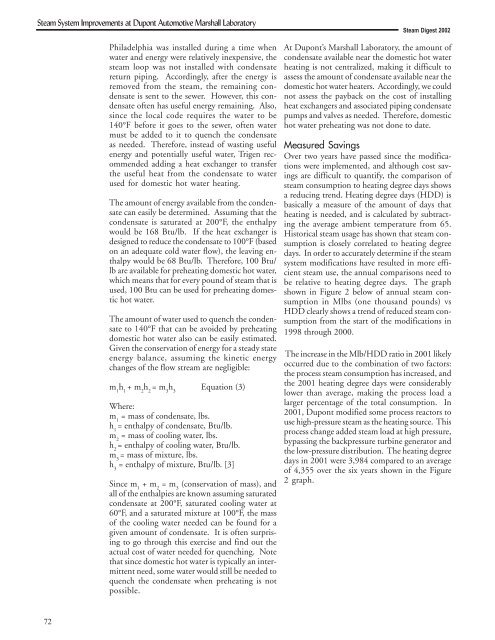Steam Digest 2002 - CiteSeerX
Steam Digest 2002 - CiteSeerX
Steam Digest 2002 - CiteSeerX
You also want an ePaper? Increase the reach of your titles
YUMPU automatically turns print PDFs into web optimized ePapers that Google loves.
<strong>Steam</strong> System Improvements at Dupont Automotive Marshall Laboratory<br />
72<br />
Philadelphia was installed during a time when<br />
water and energy were relatively inexpensive, the<br />
steam loop was not installed with condensate<br />
return piping. Accordingly, after the energy is<br />
removed from the steam, the remaining condensate<br />
is sent to the sewer. However, this condensate<br />
often has useful energy remaining. Also,<br />
since the local code requires the water to be<br />
140°F before it goes to the sewer, often water<br />
must be added to it to quench the condensate<br />
as needed. Therefore, instead of wasting useful<br />
energy and potentially useful water, Trigen recommended<br />
adding a heat exchanger to transfer<br />
the useful heat from the condensate to water<br />
used for domestic hot water heating.<br />
The amount of energy available from the condensate<br />
can easily be determined. Assuming that the<br />
condensate is saturated at 200°F, the enthalpy<br />
would be 168 Btu/lb. If the heat exchanger is<br />
designed to reduce the condensate to 100°F (based<br />
on an adequate cold water flow), the leaving enthalpy<br />
would be 68 Btu/lb. Therefore, 100 Btu/<br />
lb are available for preheating domestic hot water,<br />
which means that for every pound of steam that is<br />
used, 100 Btu can be used for preheating domestic<br />
hot water.<br />
The amount of water used to quench the condensate<br />
to 140°F that can be avoided by preheating<br />
domestic hot water also can be easily estimated.<br />
Given the conservation of energy for a steady state<br />
energy balance, assuming the kinetic energy<br />
changes of the flow stream are negligible:<br />
m h + m h = m h Equation (3)<br />
1 1 2 2 3 3<br />
Where:<br />
m = mass of condensate, lbs.<br />
1<br />
h = enthalpy of condensate, Btu/lb.<br />
1<br />
m = mass of cooling water, lbs.<br />
2<br />
h = enthalpy of cooling water, Btu/lb.<br />
2<br />
m = mass of mixture, lbs.<br />
3<br />
h = enthalpy of mixture, Btu/lb. [3]<br />
3<br />
Since m 1 + m 2 = m 3 (conservation of mass), and<br />
all of the enthalpies are known assuming saturated<br />
condensate at 200°F, saturated cooling water at<br />
60°F, and a saturated mixture at 100°F, the mass<br />
of the cooling water needed can be found for a<br />
given amount of condensate. It is often surprising<br />
to go through this exercise and find out the<br />
actual cost of water needed for quenching. Note<br />
that since domestic hot water is typically an intermittent<br />
need, some water would still be needed to<br />
quench the condensate when preheating is not<br />
possible.<br />
<strong>Steam</strong> <strong>Digest</strong> <strong>2002</strong><br />
At Dupont’s Marshall Laboratory, the amount of<br />
condensate available near the domestic hot water<br />
heating is not centralized, making it difficult to<br />
assess the amount of condensate available near the<br />
domestic hot water heaters. Accordingly, we could<br />
not assess the payback on the cost of installing<br />
heat exchangers and associated piping condensate<br />
pumps and valves as needed. Therefore, domestic<br />
hot water preheating was not done to date.<br />
Measured Savings<br />
Over two years have passed since the modifications<br />
were implemented, and although cost savings<br />
are difficult to quantify, the comparison of<br />
steam consumption to heating degree days shows<br />
a reducing trend. Heating degree days (HDD) is<br />
basically a measure of the amount of days that<br />
heating is needed, and is calculated by subtracting<br />
the average ambient temperature from 65.<br />
Historical steam usage has shown that steam consumption<br />
is closely correlated to heating degree<br />
days. In order to accurately determine if the steam<br />
system modifications have resulted in more efficient<br />
steam use, the annual comparisons need to<br />
be relative to heating degree days. The graph<br />
shown in Figure 2 below of annual steam consumption<br />
in Mlbs (one thousand pounds) vs<br />
HDD clearly shows a trend of reduced steam consumption<br />
from the start of the modifications in<br />
1998 through 2000.<br />
The increase in the Mlb/HDD ratio in 2001 likely<br />
occurred due to the combination of two factors:<br />
the process steam consumption has increased, and<br />
the 2001 heating degree days were considerably<br />
lower than average, making the process load a<br />
larger percentage of the total consumption. In<br />
2001, Dupont modified some process reactors to<br />
use high-pressure steam as the heating source. This<br />
process change added steam load at high pressure,<br />
bypassing the backpressure turbine generator and<br />
the low-pressure distribution. The heating degree<br />
days in 2001 were 3,984 compared to an average<br />
of 4,355 over the six years shown in the Figure<br />
2 graph.
















